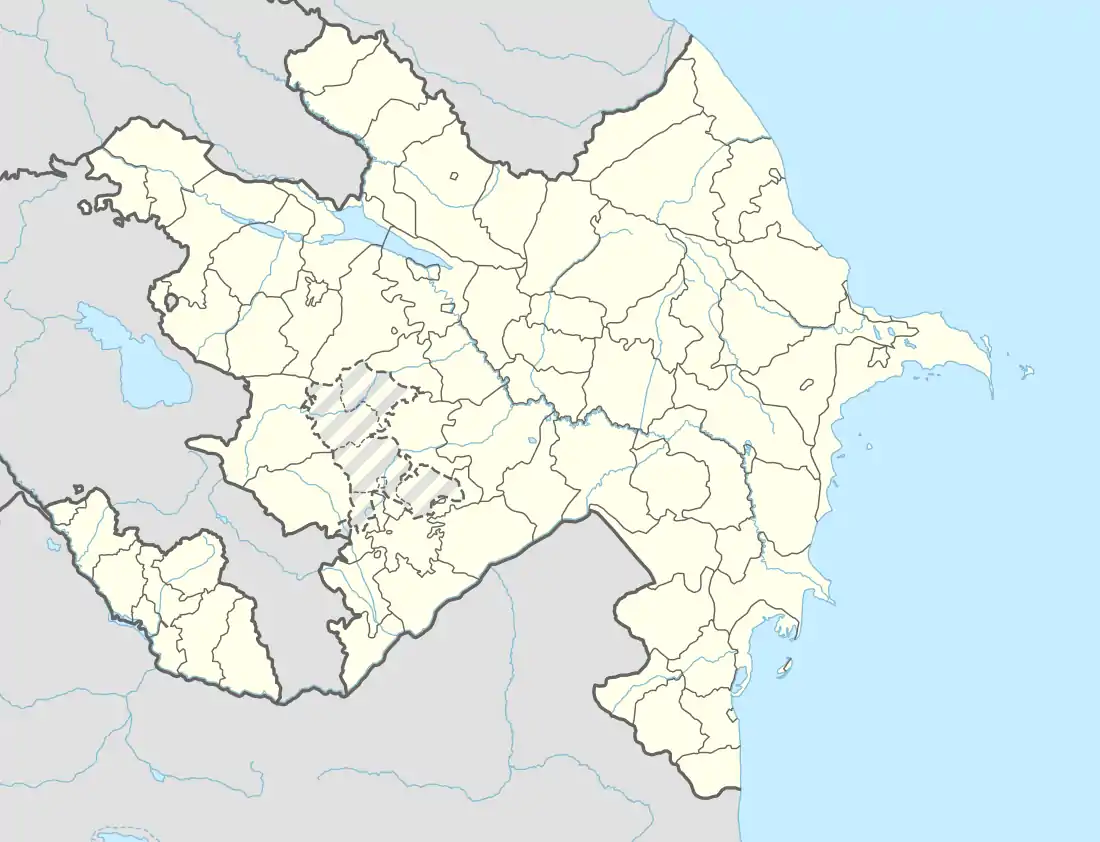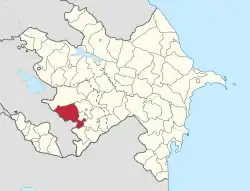Hüsülü, Lachin
Hüsülü (Husulu) is a village in the Lachin District of Azerbaijan, close to the villages of Ağoğlan and Qarıqışlaq. The Melik Haykaz Palace and the Tsitsernavank Monastery are located near the village.
Hüsülü | |
|---|---|
 Hüsülü | |
| Coordinates: 39°38′26″N 46°24′33″E | |
| Country | |
| District | Lachin |
| Elevation | 1,291 m (4,236 ft) |
| Population (2015)[1] | |
| • Total | Tsitsernavank community: 113 Melikashen village: 51 (per Artsakh) |
| Time zone | UTC+4 (AZT) |
History
Most Armenian historians identify the village with Kashataghk, a settlement mentioned by the 13th-century Armenian historian Stephen Orbelian (one Armenian historian, Armen Gharagyozian, instead identifies Kashataghk with the nearby village of Qarıqışlaq).[2] Despite the village's small size and population, the whole region of Kashatagh was named after this settlement due to it being a princely residence of the Armenian Meliks of Kashatagh. The Kurdish population that settled in the Kashatagh region after the deportation of the Armenian population from the region by Shah Abbas I[3] referred to the village as Sultankand; according to historian Samvel Karapetyan, this is because the inhabitants knew about the location's past as a princely residence.[2] The name has also been rendered as Sultanlar and Sultanlı.[4]
Under the rule of the Russian Empire, the settlement was administered as part of the Zangezur Uyezd of the Elisabethpol Governorate. According to administrative data from 1886, the settlement (recorded as two villages taken together, "First Sultankand" and "Second Sultankand") had 151 inhabitants.[5]
In Soviet times, the village was a part of the Kurdistansky Uyezd until its abolition in 1929. Thereafter, it was administered as part of the Lachin District. In 1931, the village received its current name, after the Azerbaijani communist official Hüsü Hajiyev.[4]
The village was located in the Armenian-occupied territories surrounding Nagorno-Karabakh, coming under the control of ethnic Armenian forces during the First Nagorno-Karabakh War in the early 1990s.
The village subsequently became part of the self-proclaimed Republic of Artsakh as part of its Kashatagh Province, referred to as Tsitsernavank (Armenian: Ծիծեռնավանք) or Melikashen (Armenian: Մելիքաշեն).
It was returned to Azerbaijan as part of the 2020 Nagorno-Karabakh ceasefire agreement.
Melik Haykaz Palace
A 15th-century palace of an Armenian melik, Melik Haykaz, who was the first ruler of the Agachech-Kashatagh melikdom,[6] is located close to the village.[7] The palace was built on a slope surrounded by a fortified wall with towers and gates. It had several floors, with Melik Haykaz's living room being located on the ground floor and his throne room being located on the second floor.[8] It follows the classical architectural style of an Armenian Melik Palace.[9][10] The palace underwent renovation from 1989 to 1992.[2] It was turned into a hotel in 2007.[11]
Azerbaijani sources refer to the structure as Hamza Sultan Palace, attributing it to an 18th-century local ruler named Hamza Sultan of the Qaraçorlu tribe.[4]
Gallery
 The Palace of Armenian Melik Haykazyan
The Palace of Armenian Melik Haykazyan Tsitsernavank Monastery (5th-7th centuries)
Tsitsernavank Monastery (5th-7th centuries)
References
- Hakob Ghahramanyan - Directory of socio-economic characteristics of NKR administrative-territorial units (2015)
- Samvel Karapetyan (author) (2001). Armenian Cultural Monuments in the Region of Karabakh (PDF). RAA. p. 147-149.
- Шнирельман В.А. Войны памяти: мифы, идентичность и политика в Закавказье. — ИКЦ «Академкнига», 2002. — С. 199. — ISBN 5-94628-118-6
- Aliyeva, R. (2007). Azərbaycan toponimlərinin ensiklopedik lüğəti (in Azerbaijani). Baku: Şərq-Qərb. p. 330. ISBN 978-9952-34-155-3.
- Hakobyan, Tadevos Kh.; Melik-Bakhshyan, Stepan T.; Barseghyan, Hovhannes Kh. (2001). Հայաստանի և հարակից շրջանների տեղանունների բառարան [Dictionary of toponymy of Armenia and adjacent territories] (in Armenian). vol.4. Yerevan: Yerevan State University Publishing House. p. 703.
- Maghalyan A. V. PhD in History (2015). "Falsification Of The History Of The Artsakh Meliqdoms By Azerbaijani Historiography" (PDF).
according to the famous Armenian historian Arakel Davrizhetsi, whose work is known to G. Mamedova as well, among the authorities that went to Iran’s Shah-Abbas I in 1603 to ask him to save them from the Ottoman despotism there also was “from the Armenian nation...Meliq Haykaz from the country of Kshtagh
- Artak Ghulyan. "Castles (Palaces) Of Meliks Of Artsakh And Siunik".
2. The palace of Kashatagh (15th cent.) (pl. 2-3, I) is situated on the left bank of Tzitzernavanits tributary of the Aghavno river in the district of Kashatagh (Lachin). It refers to Melik-Haykaz the First (1450 - 1520), the founder of melikal principality of Kashatagh and is dated the end of the 15th cent. It is built on the slope of a hill, on the altitude created with brace walls. It consists of three smoothly covered, adjoined rooms, a colonnade arched hall and a two-storied vaulted hall adjoined to them from the west and the melik's flat is on the first floor and the open upper hall -the summer reception-throne hall -of Melik Haykaz is on the second floor. The compositional form created with a colonnade and two-storied hall of the fortified palace is the oldest and most entire one among the similar monuments.
- Vigen Avetisyan (2019). "The Armenian Kingdom Of Kashatagh – This Is Not A "Safety Zone", This Is Our Homeland".
The village of Melikashen houses the palace of Kashatagh meliks built in the 1480s. The Melikatun (Melik House) complex is surrounded by a fortified wall with a tower and a gate. The palace consists of two-story chambers with vaulted rooms and other buildings. This structure was built by Melik Haykaz in 1480.
- Artak Ghulyan. "Castles (Palaces) Of Meliks Of Artsakh And Siunik".
The melikal palaces have mainly been the defence point, the special citadel of the residence-center, and they have also been called fortresses for this reason (Kashatagh, Kaghakategh, Mokhratagh, Horekavan, Gulatagh, Shushi).
- "Kashatagh (Lachin) province". ArCgroup. 2001.
Based on the research of 1985 architect Artak Ghulian provided the first architectural description of the princely quarters. In this regard he has particularly stated that "being the continuation of traditional forms and volumes annlied in the compositional resolution of the palaces of Khachen and Vayots Dzor of the 12th-14th centuries, the planning and volume of Kashatagh castle is a link between the further development of the 17th-18th cent melik residences frequent in Karabakh and Zanghezoor".
- Rouben Galichian (2012). "The Invention of History- Azerbaijan, Armenia and the Showcasing of Imagination". HayBook.
To pinpoint the outright lies contained in the table it is sufficient to look at page 104 of the book war against Azerbaijan(see Fig. 17), where the photo of the ruined Hamza Soltan palace in the village of Hüsülü(now Melikashen), which in fact is Melik Haykaz’ summer palace, located in the District of Lachin is depicted, and then....the table claims the building has been “destroyed.” In 2007 this writer stayed in a small guesthouse in the village of Melikashen, Lachin district which was the renovated and refurbished summerhouse of Melik Haykaz

